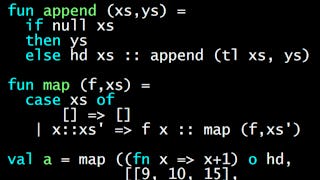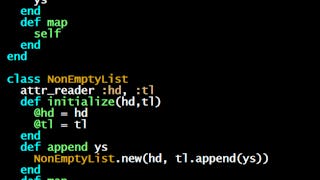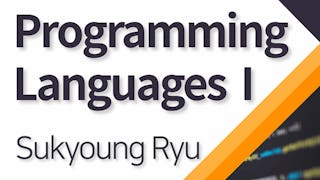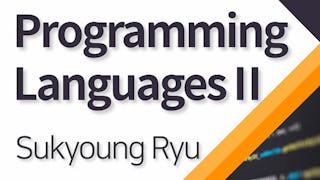What Is Programming? And How To Get Started
January 28, 2025
Article · 6 min read




Instructor: Dan Grossman
Top Instructor
64,406 already enrolled
Included with 
(781 reviews)
(781 reviews)

Add to your LinkedIn profile
1 assignment


Add this credential to your LinkedIn profile, resume, or CV
Share it on social media and in your performance review

[As described below, this is Part B of a 3-part course. Participants should complete Part A first -- Part B "dives right in" and refers often to material from Part A.]
This course is an introduction to the basic concepts of programming languages, with a strong emphasis on functional programming. The course uses the languages ML, Racket, and Ruby as vehicles for teaching the concepts, but the real intent is to teach enough about how any language “fits together” to make you more effective programming in any language -- and in learning new ones. This course is neither particularly theoretical nor just about programming specifics -- it will give you a framework for understanding how to use language constructs effectively and how to design correct and elegant programs. By using different languages, you will learn to think more deeply than in terms of the particular syntax of one language. The emphasis on functional programming is essential for learning how to write robust, reusable, composable, and elegant programs. Indeed, many of the most important ideas in modern languages have their roots in functional programming. Get ready to learn a fresh and beautiful way to look at software and how to have fun building it. The course assumes some prior experience with programming, as described in more detail in the first module of Part A. Part B assumes successful completion of Part A. The course is divided into three Coursera courses: Part A, Part B, and Part C. As explained in more detail in the first module of Part A, the overall course is a substantial amount of challenging material, so the three-part format provides two intermediate milestones and opportunities for a pause before continuing. The three parts are designed to be completed in order and set up to motivate you to continue through to the end of Part C. Week 1 of Part A has a more detailed list of topics for all three parts of the course, but it is expected that most course participants will not (yet!) know what all these topics mean.
Welcome! Start here! Learn about this course and how it's organized.
3 videos2 readings
Let's get started programming with Racket and then learning idioms related to delaying evaluation. The welcome message has a few additional comments about picking up a new language and how to approach the homework assignment, so let's get started...
23 videos6 readings1 programming assignment1 peer review
Welcome to the second week of Part B where we will focus on (a) building data structures in dynamically typed languages and (b) implementing programming languages with interpreters. Most of the programming assignment is focused on (b) -- implementing a small programming language that has function closures. As usual, start with the welcome message and enjoy!
9 videos6 readings1 programming assignment1 peer review
In the last module of Part B we will use our experience programming in ML and Racket to compare and contrast static typing and dynamic typing. This is not only the most important difference between these two languages, but it is a fundamental topic in the study of programming languages. Learning it can help you program more effectively in both kinds of languages. After completing this week's quiz, don't forget to watch the Part B Wrap-Up and Part C Preview video.
8 videos5 readings1 assignment
We asked all learners to give feedback on our instructors based on the quality of their teaching style.



Founded in 1861, the University of Washington is one of the oldest state-supported institutions of higher education on the West Coast and is one of the preeminent research universities in the world.

University of Washington
Course

University of Washington
Course

Korea Advanced Institute of Science and Technology(KAIST)
Course

Korea Advanced Institute of Science and Technology(KAIST)
Course




781 reviews
93.85%
5.50%
0.64%
0%
0%
Showing 3 of 781
Reviewed on Mar 18, 2018
This course (as Part A and C) is great - Dan is great in teaching and the content is perfect for anyone who wants to learn more about programming languages!Warning - you might end up loving FP :)
Reviewed on May 31, 2017
The course is really fantastic! It leads me to the world of Racket programming and guides me to many concepts in programming language theory (PLT).
Reviewed on Sep 27, 2021
Fantastic course on functional programming, programming languages, and type theory. Highly recommended. Dan is an amazing teacher and the course structure and pace is excellent.

Unlimited access to 10,000+ world-class courses, hands-on projects, and job-ready certificate programs - all included in your subscription
Earn a degree from world-class universities - 100% online
Upskill your employees to excel in the digital economy
Access to lectures and assignments depends on your type of enrollment. If you take a course in audit mode, you will be able to see most course materials for free. To access graded assignments and to earn a Certificate, you will need to purchase the Certificate experience, during or after your audit. If you don't see the audit option:
The course may not offer an audit option. You can try a Free Trial instead, or apply for Financial Aid.
The course may offer 'Full Course, No Certificate' instead. This option lets you see all course materials, submit required assessments, and get a final grade. This also means that you will not be able to purchase a Certificate experience.
When you purchase a Certificate you get access to all course materials, including graded assignments. Upon completing the course, your electronic Certificate will be added to your Accomplishments page - from there, you can print your Certificate or add it to your LinkedIn profile. If you only want to read and view the course content, you can audit the course for free.
You will be eligible for a full refund until two weeks after your payment date, or (for courses that have just launched) until two weeks after the first session of the course begins, whichever is later. You cannot receive a refund once you’ve earned a Course Certificate, even if you complete the course within the two-week refund period. See our full refund policy.
Yes. In select learning programs, you can apply for financial aid or a scholarship if you can’t afford the enrollment fee. If fin aid or scholarship is available for your learning program selection, you’ll find a link to apply on the description page.
Financial aid available,
New to Coursera?
Having trouble logging in? Learner help center
This site is protected by reCAPTCHA Enterprise and the Google Privacy Policy and Terms of Service apply.